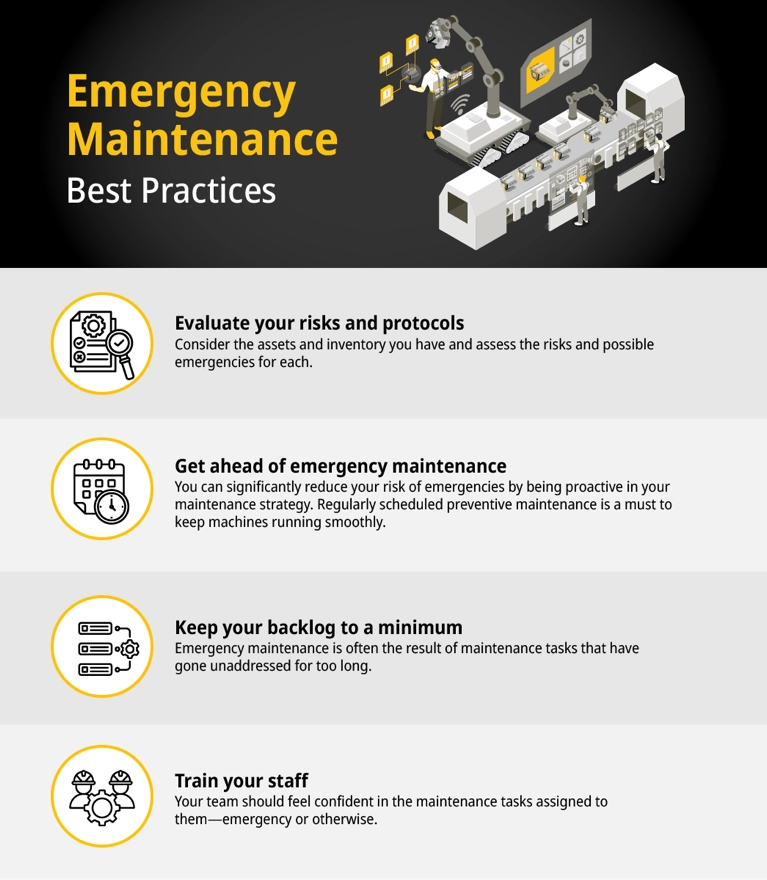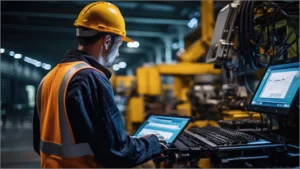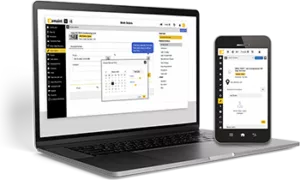What Is Emergency Maintenance?
Emergency maintenance is urgent repair work required when equipment unexpectedly fails and poses an immediate risk to safety or operations. This type of urgent maintenance needs to be completed as soon as possible to restore functionality and prevent injury to employees or damage to assets.
Emergency maintenance is the ultimate test for any organization. It means that some aspect of your operations has gone disastrously wrong and requires immediate attention to prevent further risk to health and safety. Emergency maintenance is also needed if a critical asset has failed and brought the production line screeching to a halt, preventing the entire plant from operating as it should.
These types of emergencies can be expensive. Such unpredictable and sudden events may call for all hands available to stop what they’re doing and focus on preventing the crisis from escalating. Costs can rise quickly because of the need to rush replacement parts orders, pay unexpected overtime, replace or repair surrounding equipment due to unexpected damage, and other costly line items that cut into an organization’s bottom line.
Emergency maintenance is unpredictable, but emergencies do happen, and your team must be prepared to handle them when they occur.
When Does Maintenance Become Emergency Maintenance?
As any maintenance technician can attest, failures are a normal part of business operations. But not every maintenance issue is considered an emergency, and it’s important for your team to be able to recognize the difference between a maintenance emergency and less urgent maintenance.
Here are a few categories of questions your team can answer to help determine whether you’re dealing with regular maintenance or emergent breakdown maintenance.
- Safety and Compliance Risks
- Does the problem pose an immediate safety risk to employees, customers, or the public?
- Could the failure lead to regulatory non-compliance or violations?
- Is there a risk of fire, electrocution, explosion, or hazardous material exposure?
- Equipment and Operational Impact
- Will the failure cause critical production downtime?
- Is there a risk of cascading damage to other systems or equipment?
- Does the issue prevent essential services (HVAC, electrical, water, etc.) from functioning?
- Is the equipment at risk of catastrophic failure if not addressed immediately?
- Financial and Cost Considerations
- Will delaying repairs result in significantly higher repair costs?
- Is there a risk of major product loss, spoilage, or inventory damage?
- Does the issue impact customer commitments?
- Workarounds and Temporary Solutions
- Can the issue be temporarily corrected with a workaround?
- Are backup systems available to maintain operations?
Every situation is different, but answering these questions can help you decide if the problem is an emergency, warrants a top-priority work order, or can wait for routine maintenance during normal business hours.
3 Types of Emergency Maintenance Requests
Across various industries, there are three common types of emergency maintenance requests.
Emergency automated maintenance takes place without human intervention. Instead, an automatic system initiates a safety protocol or shuts down to avoid immediate damage. This is common in the production or processing of hazardous materials. Utility companies, such as natural gas and electric companies, also employ this method.
Automated response maintenance requests also happen automatically, triggered by critical system failures. These electronic maintenance requests alert human technicians to issues that require immediate attention. This type of request is common in property management. For example, elevator breakdowns may trigger automated response maintenance requests.
Finally, human requests occur when maintenance teams — or any humans present during an emergency maintenance situation — submit manual maintenance requests. Maintenance teams may flag an emergency in a plant, warehouse, or the grounds of any type of building. But in public spaces or private residences, civilians may call attention to an issue that compromises health and safety or threatens serious property damage.
The right type of response depends on your industry, equipment type, failure type, and threat of the emergency — whether it poses an immediate threat to health and safety, property, inventory, or something else. While you can’t completely avoid emergency maintenance concerns, choosing the right response helps mitigate and streamline these tasks.
Benefits and Challenges of an Emergency Maintenance Strategy
It’s essential to have an emergency maintenance strategy because it keeps your facilities and employees safe when something unexpected occurs. However, it’s risky and ineffective to rely on emergency maintenance alone. Here are the benefits of your emergency maintenance strategy, alongside the challenges of overreliance.
Benefits
- Simple, low-cost implementation. Emergency maintenance doesn’t require large-scale changes to daily operations. And since maintenance is less frequent, you save time and resources (at least, until an emergency occurs).
- Employees are free to prioritize based on urgency, without worrying about an emergency throwing their daily or weekly maintenance tasks off schedule.
- Data-driven assessments. Tracking real-time emergencies by equipment, failure type, and more can help you identify trends for immediate or long-term improvement.
Challenges
- Unplanned downtime. Proactive maintenance plans allow for planned downtime, which enables consistent equipment performance and minimizes emergencies. Overreliance on emergency maintenance can increase the frequency and duration of unplanned downtime.
- Unpredictable costs. With a proactive approach, you can repair parts and predict when you’ll need to replace them. But emergency maintenance is more likely to require replacement instead of repair, which can take longer and cost more. Plus, since it’s difficult to predict which part will malfunction, you might not have the correct part in your inventory.
- Resource allocation. Some days will have fewer maintenance emergencies, which may leave maintenance teams without enough to do. But days with more failures may leave your team understaffed and unable to promptly and effectively respond to every emergency.
Emergency maintenance is a critical part of your overall maintenance strategy. Still, it’s best to prioritize a proactive approach.
Emergency Maintenance Best Practices
Although your emergency strategy will be unique to your company’s size and scope, there are four rules that can help guide any emergency maintenance plan:

1. Evaluate Your Risks and Emergency Protocols
Consider the assets and inventory you have and assess the risks and possible emergencies for each. Make sure your team understands what constitutes an emergency and establish clear workflows for emergency response. For example, how will personnel submit an emergency request? What approvals are required? Who is qualified to respond in an emergency situation? And so on.
2. Get Ahead of Emergency Maintenance With Preventive and Predictive Maintenance
You can significantly reduce your risk of emergencies by being proactive in your maintenance strategy. Regularly scheduled preventive maintenance is a must to keep machines running smoothly. You can also take it a step further by using condition monitoring to keep a pulse on the health of your equipment and get alerted when problems start brewing. Using this condition monitoring data to predict and resolve maintenance issues before they escalate is known as predictive maintenance.
To learn more, see our article How To Shift to a Predictive Maintenance Strategy.
3. Keep Your Maintenance Backlog to a Minimum
Emergency maintenance is often the result of maintenance tasks that have gone unaddressed for too long. When you have too long of a backlog, it also often means you are understaffed, and your team will struggle to adequately respond to emergency situations.
4. Train Your Staff

Your team should feel confident in the maintenance tasks assigned to them—emergency or otherwise. A leading cause of emergency situations is human error, so making sure your team has the tools, training, and time they need to perform their tasks thoroughly and accurately will go a long way towards preventing emergencies in the first place. And if an emergency does occur, they should be well-prepared to respond accordingly.
Examples of Emergency Maintenance
Unplanned maintenance doesn’t always mean an emergency. An urgent maintenance request also may not be an emergency. However, true emergency maintenance is a critical situation and requires an immediate response. Here are some common scenarios that call for emergency repairs in industrial settings:
- A gas leak that poses an explosion risk.
- A fire alarm system failure.
- Exposed live wires or electrical faults that could cause electrocution.
- An HVAC system breakdown in a hospital or food storage facility, risking patient health or product spoilage.
- A burst pipe flooding a warehouse or office building.
- A surveillance system failure in a high-security facility.
- Total failure of production-critical assets.
Each of these situations can be dangerous to employees and result in serious damage to assets, buildings, and inventory. They can have serious consequences and should be dealt with as quickly as possible.
What Are the 4 Types of Maintenance? Reactive vs Proactive Maintenance Strategies
There is a major difference between emergency maintenance — which must be resolved regardless of the hour — and urgent problems that can wait until regular business hours.
The four basic maintenance strategies are:
- Preventive maintenance (PM): Aims to reduce downtime and prolong asset lifespans through performing regular maintenance at time- or usage-based intervals.
- Predictive maintenance (PdM): Uses real-time monitoring to assess asset health and performance, reducing unnecessary replacement and repair while preventing failure.
- Reliability-centered maintenance (RCM): Analyzes potential failures across all assets to prioritize the best approach for each individual asset.
- Reactive maintenance (RM): Creates and prioritizes work orders only once an asset has failed (also known as run-to-failure). This includes emergency maintenance.
It’s best to use a combination of proactive and reactive maintenance strategies. For example, preventive maintenance may lead to overreplacement — replacing parts that still have a safe, usable lifespan. But reliability-centered maintenance helps assess the useful life of a part or asset, so maintenance teams can make informed decisions about part replacement.
Similarly, relying solely on reactive maintenance may save money on preventive maintenance in the short term, but can lead to higher costs overall. Equipment failures often require replacement parts, instead of repairs. And while this approach has minimal planned downtime compared to more proactive maintenance strategies, you’ll likely see more unplanned downtime and urgent repairs outside of normal business hours.
Both emergency maintenance and corrective maintenance are types of reactive maintenance, which just means that the maintenance is not planned. These types of maintenance activities are a reaction to a situation that has already occurred. That makes them very different from proactive maintenance strategies like preventive and predictive maintenance.
Difference Between Emergency Maintenance and Preventive Maintenance
Preventive maintenance is meant to prevent emergencies with strategic planning and scheduling. Preventive maintenance typically involves following a time-based schedule (also known as calendar-based maintenance) or a usage-based schedule (also known as runtime-based maintenance) to keep equipment running smoothly. A computerized maintenance management system (CMMS) helps maintenance teams stay on track with scheduled maintenance and keep detailed maintenance records for all assets.
To learn more, see What Is Preventive Maintenance?
Difference Between Emergency Maintenance and Corrective Maintenance
Like emergency maintenance, corrective maintenance, or breakdown maintenance, is a reaction to any sort of equipment failure. Corrective maintenance, however, is used for non-emergency situations. A corrective maintenance strategy is needed for fairly obvious problems that require attention but haven’t escalated to the point of shutting down production or causing a safety issue.
For example, if a component or non-critical asset breaks between scheduled maintenance visits, you would perform corrective maintenance to repair it. The issue was not planned and requires corrective action, making it reactive maintenance — but it’s not an emergency.
A clogged toilet may be a non-emergency maintenance concern if it simply puts the toilet out of commission. However, it may be an emergency maintenance situation if a sewage backup or burst pipe floods the entire building and compromises the building’s assets.
Both corrective and emergency maintenance plans should be prepared so that your team can respond appropriately to both emergency and non-emergency maintenance issues .
How To Respond to a Maintenance Emergency Request
Emergency maintenance requests are serious, and it’s crucial to handle them properly to avoid repair delays and ensure clear communication between team members. Here are the best practices teams should follow when responding to emergency maintenance requests:
- Acknowledge Receipt of the Request Immediately: Confirm the receipt of the work order by notifying the requestor as soon as possible. If you’re using a paper work order system, you may need to make a phone call. If using a CMMS, this happens automatically.
- Assess the Severity: Determine if the problem meets emergency maintenance criteria by using the checklist above. If the situation is unclear, send a technician to perform an on-site assessment.
- Ensure Safety: If there is a safety risk (electrical hazard, gas leak, structural damage, etc.), secure the area and notify the necessary personnel. Shut down affected equipment if running it could cause further damage. Follow lockout/tagout (LOTO) procedures if applicable.
- Assign Technician(s): Dispatch the appropriate technicians based on the type of issue (electrical; mechanical; heating, ventilation, and air conditioning [HVAC]; plumbing; etc.). Ensure they have the necessary tools and parts. Communicate expected arrival time to the requester or operations team.
- Execute Repairs: Technicians should perform the necessary diagnosis and perform repairs or, if not possible, stabilize the situation until repairs can be performed. Keep the rest of the team informed of progress.
- Restore Operations: Test equipment involved in the repairs to ensure repairs have been completed and all equipment is functioning correctly. Update your work order log or CMMS to note which repairs were completed.
- Conduct Post-Maintenance Review: If possible, identify the root cause of the failure that led to the emergency. Update preventive maintenance schedules to help avoid this type of failure in the future.
Emergency Maintenance Situations: Industry Use Cases
How do emergency maintenance issues show up in specific industries?
Manufacturing
Essential manufacturing equipment fails, causing production delays and putting worker safety at risk. With the right condition-based maintenance tools and systems in place, the equipment automatically shuts down and triggers an emergency maintenance work order for immediate repair. Teams restore the equipment safely and efficiently.
Energy, Natural Gas, and Other Utilities
A malfunctioning solar panel creates an arc flash during otherwise normal operations. The built-in safety system activates automatically. However, the panel needs immediate inspection and repair to diagnose the issue, ensure the rest of the power station is safe, and resume normal operations. With advanced maintenance management software, teams receive instant alerts and automated work orders to carry out efficient inspection and repair.
Fleet Maintenance
A truck breaks down during service, delaying a series of critical and time-sensitive deliveries. The team receives initial data, driver notes, and location information to determine whether to repair the truck onsite or send a replacement. This automated process reduces downtime, allowing efficient recovery to resume essential deliveries.
Property Management and Hospitality
A power outage impacts your entire building, leaving residents trapped inside an elevator without air conditioning during an extreme heat event. Your generator powers on, but the circuit breaker, elevator, and HVAC systems require manual repair.
Automated alerts notify your maintenance team before the callbox does, dispatching the nearest technician for diagnostics and repair while the property manager or other representative speaks with the residents. Real-time data and faster response times can improve diagnosis and speed up repairs in your apartment buildings — especially valuable for medical emergencies.
Healthcare
An essential piece of lab equipment fails, delaying crucial testing for emergency room patients. Real-time reporting enables techs to diagnose the issue remotely, before arriving on site. This allows them to bring the right tools and replacement parts, meaning the issue is resolved quickly — potentially saving lives.
How To Minimize or Avoid Emergency Maintenance Issues
While preventive maintenance as a part of a Maintenance, Repair, and Operations (MRO) plan can prevent many unexpected failures, some failures simply can’t be predicted. Minimizing emergency maintenance starts with having a strong MRO strategy.
Preventive maintenance includes performing regular inspections of equipment and components, as well as performing tasks like lubrication, oil changes, filter changes, and other needed maintenance. Staying on top of this type of maintenance keeps assets running smoothly and can help avoid emergency repairs.
Predictive maintenance involves using sensors that track asset temperature or vibration. Warmer-than-usual temperatures or higher-than-usual vibration readings can indicate a developing problem. When the sensors note these changes, a CMMS can send an alert to technicians. Then, the technicians can inspect the asset and perform any needed repairs before a major failure occurs.
Sometimes, needed maintenance is put off to a later date due to budget constraints or other problems. Carefully selecting which maintenance tasks qualify for deferred maintenance and which tasks should be prioritized can also help minimize reactive maintenance and emergency maintenance.
Stay Prepared for Any Maintenance Challenge
Emergency maintenance is a critical aspect of any organization’s operational preparedness, ensuring maintenance teams are prepared to take action quickly to prevent risks to health, safety, and production. To effectively manage emergencies and streamline your maintenance processes, consider leveraging a comprehensive CMMS like eMaint to take control of your maintenance management.


